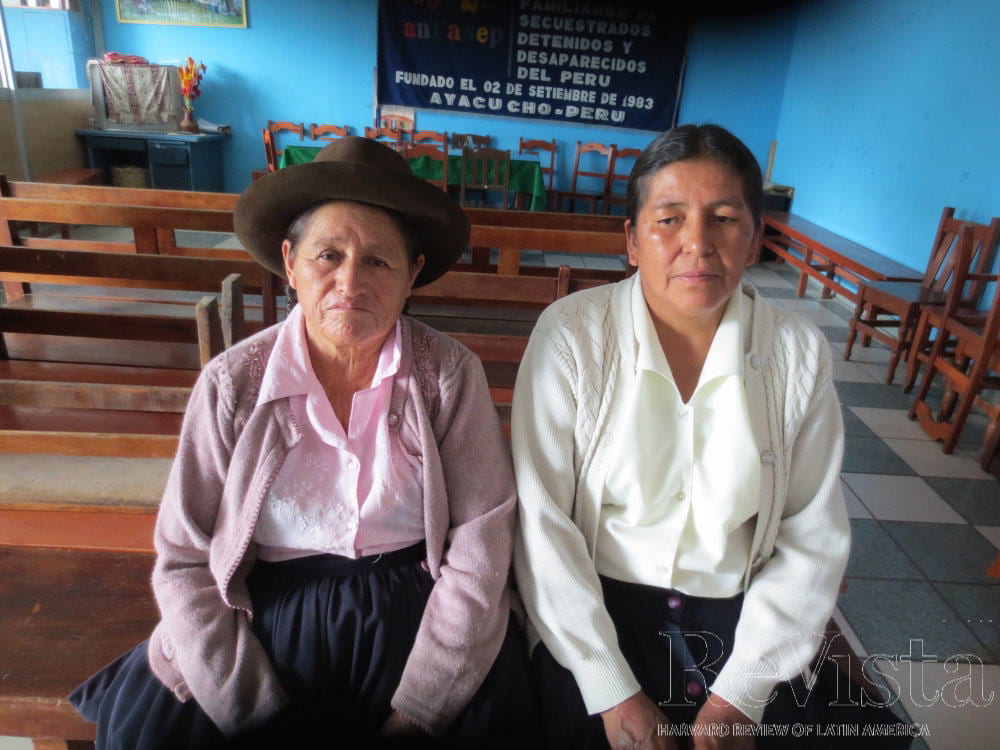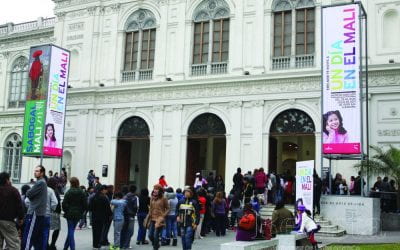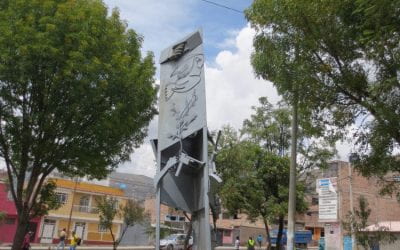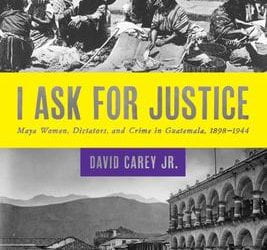A Road Less Traveled By
Difficult Post-Conflict Reconciliation Process
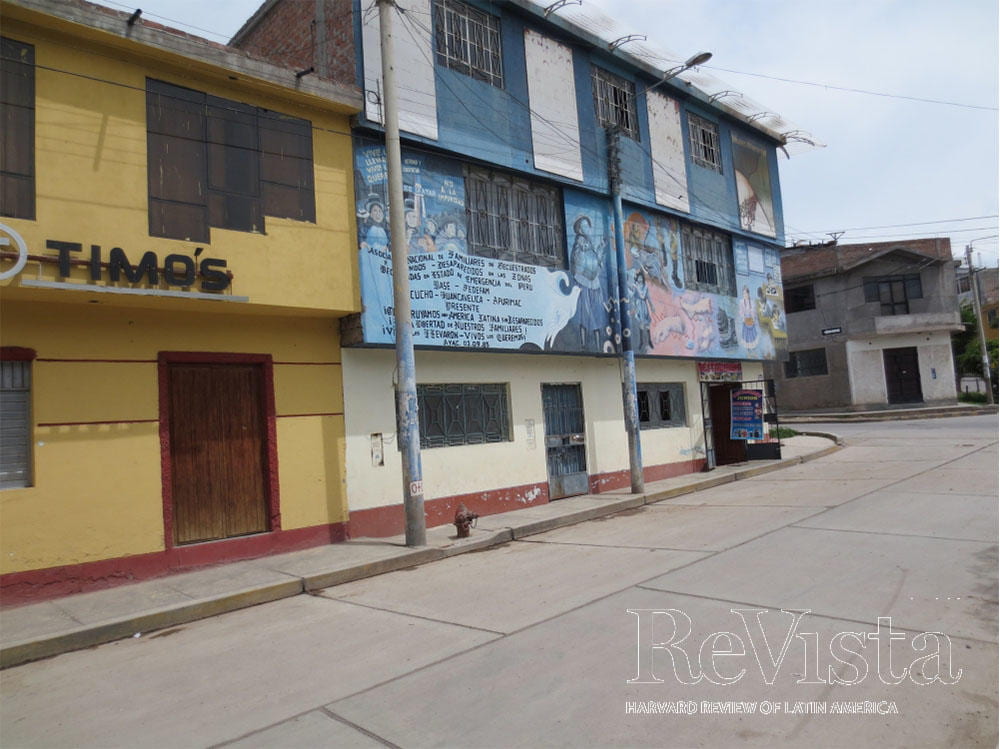
A mural on the Memory Museum Wall in Ayacucho renders honor to victims of the violence. Photo by June Carolyn Erlick.
In mid-1992, Peru’s Shining Path guerrillas were winning. They had Lima under siege. Electricity was erratic, and water even more so. On July 16, their bombs destroyed banks, businesses and an apartment building in the middle-class Lima district of Miraflores, with many innocent lives lost. Their maximum leader, Presidente Gonzalo, a.k.a. Abimael Guzmán Reynoso, declared that victory was imminent. He had even drawn up plans for Shining Path’s final offensive in October. The radical Maoist organization’s “New Democracy” would take over by December, the month of both Mao’s and Guzmán’s birthdays.
By September 12, the guerrilla juggernaut was sent reeling with the dramatic capture of its maximum leader in a perfectly coordinated elite police unit operation. Violence spiked for a few months, but then ebbed rapidly. Shining Path soon ceased to pose a threat to the state, and has never recovered.
Multiple accounts have analyzed how the conflict ended and peace was restored, most notably those of the late and much lamented Carlos Iván Degregori in How Difficult It Is to Be God: Shining Path’s Politics of War in Peru, 1980-1999 (2013); Carlos Tapia, in Las Fuerzas Armadas y Sendero Luminoso (1997); and Benedicto Jiménez, Inicio, desarrollo y ocaso del terrorismo en el Perú (2000). These and other accounts help to show just how complex and multifaceted the process of conflict resolution was. Over subsequent years, however, there has been a growing appreciation of the multiple challenges that have made the post-conflict reconciliation process even more difficult to achieve. There are a number of reasons why this has been the case.
1. Most killings took place in the countryside among peasant communities, virtually unseen by limeños (residents of Lima) and coastal city dwellers.
The worst years of the violence, 1983 through 1993, devastated the more remote departments of the Peruvian sierra—the Ayacucho region in particular, but also Huancavelica and Apurímac. Documentation of the magnitude of loss of life in these regions occurred only after the establishment of the Truth and Reconciliation Commission (Comisión de la Verdad y Reconciliación—CVR) in 2001. Over the course of its two-year mandate, hundreds of bilingual interviewers carried out in-depth fieldwork throughout these areas. They found hundreds of mass graves and documented thousands of previously unrecorded killings. The conclusions of their final 2003 report, nine volumes of fine-grained analysis and details drawn from interviews and on-site inspections, estimated more than 69,000 conflict-related deaths, almost twice the number previously reported. This report also concluded that the majority of those killed were Quechua-speaking indigenous peasants.
2. The gulf between the coast and highlands—geographical, historical, cultural and ethnic in nature—further limited the impact of generalized political violence in the sierra on coastal Lima, Peru’s political, economic and social center.
Centuries of Spanish domination and centralized governmental control based on the coast were reinforced by a forbidding geography and a largely indigenous sierra; this contributed to a long-standing neglect of the “other” Peru and a tendency to overlook its problems. As a result, authorities initially failed to appreciate the danger posed by Shining Path guerrillas there. When they finally did respond, they emphasized the use of military force, which only increased levels of violence and repression. The coastal center eventually recognized its mistakes. Under great duress, Lima-based authorities instituted a comprehensive shift in their counterinsurgency strategy, which ultimately proved successful in defeating the insurgents. The process of reconciliation, difficult enough in its own right, has faced a similar set of challenges of coastal center indifference to the “other” Peru.
3. Presidential failures delayed or thwarted the post-conflict reconciliation process.
Alberto Fujimori (1990-2000) had a historic opportunity to move forward on such a process in the late 1990s with the defeat of Shining Path and the restoration of peace in the sierra. Despite significant first steps emphasizing rural highland micro-development, he squandered both the opening to development and his own legacy by focusing instead on an increasingly authoritarian political project designed to keep himself in power. After his removal by Congress, Valentín Paniagua’s transitional government (2000-2001) established the CVR in 2001, and Alejandro Toledo’s administration (2001–2006) established the legal framework for reparations in 2005 and 2006.
During his second administration, however, Alan García (2006–2011) actively impeded progress on the implementation of reparations in Ayacucho. His government stopped funding Peruvian exhumation teams, replaced an activist public defender and moved a trial of military officers accused of extra-judicial killings to Lima in order to make it financially impossible for indigenous claimants to testify. It also delayed authorizations and funding in 2009–2010, forcing the Reparations Council established during the Toledo government to furlough personnel and delay victim registration. Once the budget did go forward, it was limited to less than US$15 million a year, a small fraction of what was needed. In addition, his administration’s 2011 decree closed the victim register and limited individual payments to US$3,700.
One explanation offered for these actions was García’s fear that evidence might be uncovered that could tie him and his first government to human rights abuses in Ayacucho, for which he could be brought to justice. Even so, the first collective reparations took place during the last three months of García’s second administration in the midst of the 2011 presidential election campaign (1,500 communities received about US$18,500 apiece). Many attributed this significant but belated gesture to his thinly disguised ambition to become a presidential candidate once again in 2016.
4. Some political elites engaged in serious efforts to discredit the CVR and its report.
The CVR’s nine-volume study of the conflict between 1980 and 2000 was widely considered to be a definitive treatment of the violence. Its detailed fieldwork provided meticulous documentation as the basis for its analysis and recommendations. Even so, a number of political figures and media outlets questioned both the objectivity of the members of the commission and the veracity of the report. Their objections centered on the numerous accounts contained therein of serious abuses by police and military forces, even though the narrative gave as much or even more attention to Shining Path militant excesses. Many, particularly Lima-based critics, cast doubt on the entire report and its recommendations as a key component of the reconciliation process. Such questioning contributed to delays in legislation designed to flesh out the reparations process.
5. Political violence often involved fratricide—killings within the same family—and members of the same community—“communicide,” thus making reconciliation at the local level extremely difficult.
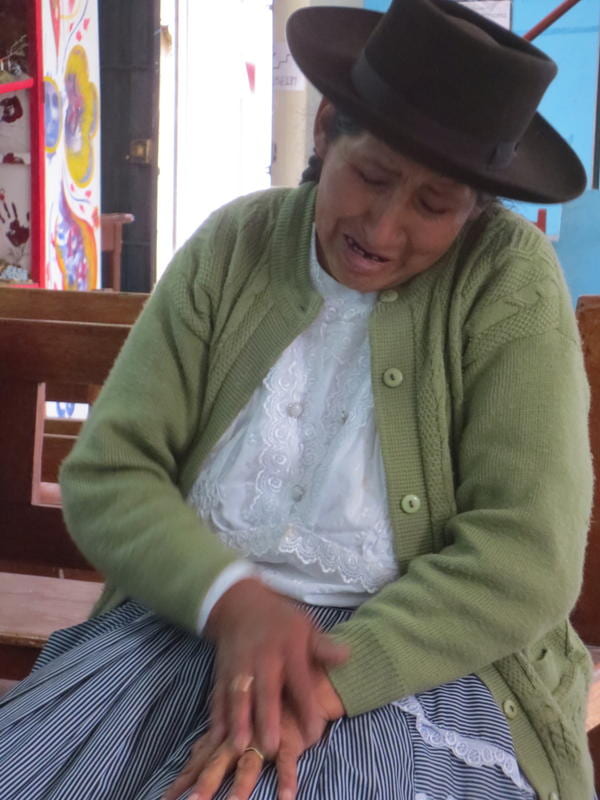
Leaders of the Association of Relatives of the Kidnapped, Detained and Disappeared of Peru (ANFASEP). Photo by June Carolyn Erlick.
A number of anthropologists, including Olga González (Unveiling Secrets of War in the Peruvian Andes, 2011) and Kimberly Theidon (Intimate Enemies, 2013), have carried out significant field research in the Ayacucho region since the end of the conflict. They document the degree to which the generalized political violence throughout the region was all too often reflected in killings of both family and fellow community members. Their ethnographies show such past internecine violence creates major challenges for post-conflict reconciliation when both perpetrators and victims continue to live in close proximity.
Their interviews reveal how some who find themselves in such post-conflict situations have found some solace in evangelical religious practices in which ultimate justice will be meted out by God. Others have turned back to traditional rituals for explanations of their experiences in the tumultuous years of violence and sorrow. Above and beyond what the central government is doing to address affected populations’ post-conflict issues, or what Theidon terms “vertical” reconciliation, it is clear that achieving what she calls “horizontal” reconciliation (i.e., among the people themselves) is a separate and even more complex problem.
Placed in context, as historian Miguel La Serna has shown most recently in The Corner of the Living: Ayacucho on the Eve of the Shining Path Insurgency (2012), intra-community conflict has been a fact of life in the Peruvian sierra for centuries. The current situation is particularly difficult in communities where Shining Path was able to gain influence and impose its control, as in Víctor Fajardo and neighboring provinces in Ayacucho. Given community members’ demonstrated ability to work through internal conflict in the past, such contemporary post-guerrilla war responses and coping mechanisms as recorded by González and Theidon appear to help fulfill the same function today. As a new generation that lacks the lived traumatic experience of their parents emerges among local indigenous populations, oral traditions will keep memories of the violence and the loss of loved ones alive.
Clearly, central government must play a major role in the reconciliation process, and the CVR’s 2003 recommendations provide a clear road map. Even so, a variety of challenges, particularly those noted above, combined to delay implementation. The past three years, however, have demonstrated significant progress.
The Ollanta Humala administration (2011–2016) has moved forward on the exhumations of mass graves, which had been almost completely thwarted during the previous government. These include several in Ayacucho, such as the communities of Chungui and Huancapi as well as the military bases in Huanta and Los Cabitos. This government has also reopened individual and collective victims’ registries, and significantly increased budget allocations for the Reparations Council. According to official reports, its budget increased from US$16 million in 2011 to US$46 million in 2012 and US$57 million in 2013. An additional 475 communities have received collective reparations, averaging US$36,000 each, about twice what was paid per community at the end of the García government. Individual reparations began in late 2011; by the end of 2013, 69 percent of registrants (54,840 of 79,564) had received compensation averaging $12,700 per victim. Other types of reparations, including education, health and symbolic gestures have also gone forward at significant levels over the past two years.
Most of the advances during the Humala administration have taken place with little fanfare or national media coverage. The significant progress made thus far is continuing, and long-standing claims by those most affected by the violence are being met at last. Central government has finally recognized the need to provide a variety of reparations to the affected as part of the reconciliation process. It has also developed the institutional capacity and financial support to carry out the legal commitments of 2005–2006.
These advances have taken place during an ongoing decline in President Humala’s approval ratings, due in large part, ironically, to perceptions that his administration has been passive and unresponsive. Yet the recent strides made in reconciliation policy suggest that public perceptions are at odds with the government’s actual achievements, at least in this area. A more cynical explanation, however, might be a lack of public interest in the policy because it is focused on the poor, the indigenous and the sierra—those most affected by the violence. Another possible explanation is simply citizen fatigue, given the long period of reparation policy gestation.
Whatever the limitations of the Humala government may be in some areas of public policy, the reparations arena is not one of them. Its members have succeeded in overcoming serious resistance and multiple obstacles to make significant advances in implementing the recommendations that the Truth and Reconciliation Commission (CVR) made more than a decade ago. At this mid-term juncture, there is every indication that progress will continue.
Related Articles
The Violence of the VIP Boxes
English + Español
In Peru, the upper class does not like to mix with those they consider different or inferior. Their maids on the beaches south of Lima are not allowed to swim in club pools and, sometimes, not even in the ocean. The VIP boxes at sports and theater events maintained by the government are a public display of a private practice that reproduces in the public sphere the worst aspect of private hierarchical structuring.
Peace and Reconciliation
English + Español
Eleven years have gone by since the Peruvian Truth and Reconciliation Commission presented its final report. The report reconstructed the history of many cases of massacres, tortures, murders and other serious crimes. At the same time, it contributed an interpretation of the…
I Ask for Justice: Maya Women, Dictators, and Crime in Guatemala, 1898–1944
On May 10, 2013, General Efraín Ríos Montt sat before a packed courtroom in Guatemala City listening to a three-judge panel convict him of genocide and crimes against humanity. The conviction, which mandated an 80-year prison sentence for the octogenarian, followed five weeks of hearings that included testimony by more than 90 survivors from the Ixil region of the department of El Quiché, experts from a range of academic fields, and military officials.

